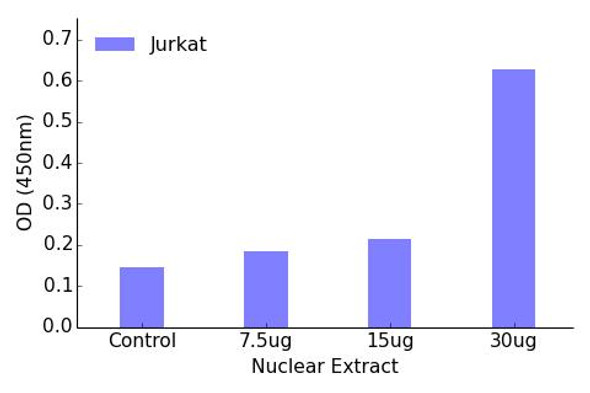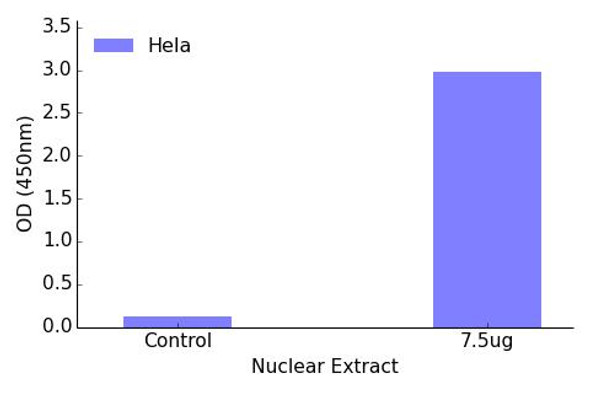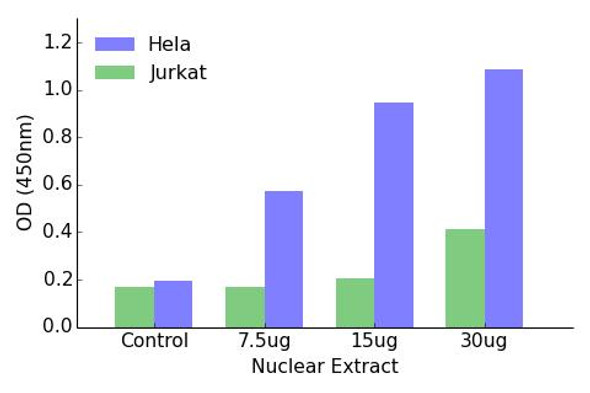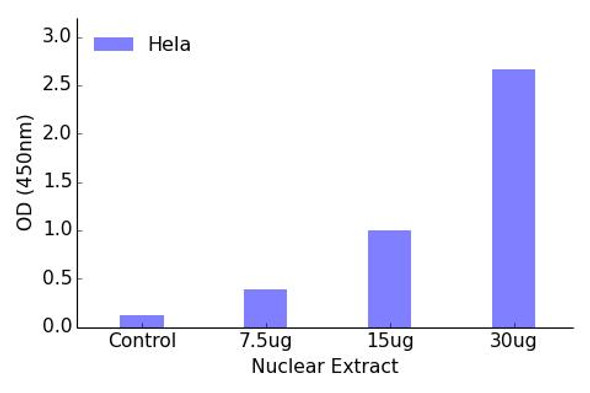Description
OCT1 Transcription Factor Activity Assay
The OCT1 (Organic Cation Transporter 1) Transcription Factor Activity Assay Kit is a highly sensitive and specific tool designed for the quantification of OCT1 transcription factor activity in cell lysates and nuclear extracts. This kit enables researchers to accurately measure OCT1 activity in various biological samples, providing valuable insights into the regulation of organic cation transport and drug metabolism.OCT1 is a key regulator of the uptake and elimination of endogenous compounds and xenobiotics in the liver and other tissues. Dysregulation of OCT1 activity has been associated with altered drug response, toxicity, and disease susceptibility.
By accurately measuring OCT1 transcription factor activity, researchers can better understand the molecular mechanisms underlying these processes and develop more effective therapeutic strategies.The OCT1 Transcription Factor Activity Assay Kit offers high sensitivity, specificity, and reproducibility, allowing for precise quantification of OCT1 activity in a wide range of experimental settings. With its user-friendly protocol and reliable results, this kit is an indispensable tool for studying the role of OCT1 in drug metabolism, toxicology, and disease pathogenesis.
| Product Name: | OCT1 Transcription Factor Activity Assay |
| Product Code: | TFAB00145 |
| Target: | OCT1 |
| Synonyms: | Organic cation transporter 1, hOCT1 |
| Reactivity: | Human, Mouse |
| Sample Types: | Nuclear or cell lysates |
The Assay Genie Oct1 transcription factor activity assay allows for the detection and qualitative analysis of endogenous levels of activated transcription factors in a variety of nuclear and cell lysates
Assay Genie ELISA kits are designed to significantly reduce experiment time and ensure sensitivity and flexibility for high-throughput screening.
| Assay Time: | 4.5 hours |
| Detection Method: | Colorimetric 450 nm |
| Size: | 12 x 8-Well Microstrips |
| Storage: | 4°C for 6 months |
| UniProt Protein Function: | SLC22A1: Translocates a broad array of organic cations with various structures and molecular weights including the model compounds 1-methyl-4-phenylpyridinium (MPP), tetraethylammonium (TEA), N-1-methylnicotinamide (NMN), 4-(4-(dimethylamino)styryl)- N-methylpyridinium (ASP), the endogenous compounds choline, guanidine, histamine, epinephrine, adrenaline, noradrenaline and dopamine, and the drugs quinine, and metformin. The transport of organic cations is inhibited by a broad array of compounds like tetramethylammonium (TMA), cocaine, lidocaine, NMDA receptor antagonists, atropine, prazosin, cimetidine, TEA and NMN, guanidine, cimetidine, choline, procainamide, quinine, tetrabutylammonium, and tetrapentylammonium. Translocates organic cations in an electrogenic and pH-independent manner. Translocates organic cations across the plasma membrane in both directions. Transports the polyamines spermine and spermidine. Transports pramipexole across the basolateral membrane of the proximal tubular epithelial cells. The choline transport is activated by MMTS. Regulated by various intracellular signaling pathways including inhibition by protein kinase A activation, and endogenously activation by the calmodulin complex, the calmodulin- dependent kinase II and LCK tyrosine kinase. Belongs to the major facilitator (TC 2.A.1) superfamily. Organic cation transporter (TC 2.A.1.19) family. 4 isoforms of the human protein are produced by alternative splicing. |
| UniProt Protein Details: | Protein type:Transporter, SLC family; Transporter; Membrane protein, integral; Membrane protein, multi-pass Chromosomal Location of Human Ortholog: 6q25.3 Cellular Component: membrane; basolateral plasma membrane; integral to plasma membrane; plasma membrane Molecular Function:protein binding; protein homodimerization activity; acetylcholine transmembrane transporter activity; norepinephrine transmembrane transporter activity; organic cation transmembrane transporter activity; secondary active organic cation transmembrane transporter activity; dopamine transmembrane transporter activity; quaternary ammonium group transmembrane transporter activity Biological Process: dopamine transport; epinephrine transport; norepinephrine transport; organic cation transport; quaternary ammonium group transport; neurotransmitter transport; multidrug transport; establishment and/or maintenance of transmembrane electrochemical gradient; transmembrane transport; protein homooligomerization |
| NCBI Summary: | Polyspecific organic cation transporters in the liver, kidney, intestine, and other organs are critical for elimination of many endogenous small organic cations as well as a wide array of drugs and environmental toxins. This gene is one of three similar cation transporter genes located in a cluster on chromosome 6. The encoded protein contains twelve putative transmembrane domains and is a plasma integral membrane protein. Two transcript variants encoding two different isoforms have been found for this gene, but only the longer variant encodes a functional transporter. [provided by RefSeq, Jul 2008] |
| UniProt Code: | O15245 |
| NCBI GenInfo Identifier: | 313104181 |
| NCBI Gene ID: | 6580 |
| NCBI Accession: | O15245.2 |
| UniProt Related Accession: | O15245 |
| Molecular Weight: | |
| NCBI Full Name: | Solute carrier family 22 member 1 |
| NCBI Synonym Full Names: | solute carrier family 22 member 1 |
| NCBI Official Symbol: | SLC22A1 |
| NCBI Official Synonym Symbols: | OCT1; HOCT1; oct1_cds |
| NCBI Protein Information: | solute carrier family 22 member 1 |
| UniProt Protein Name: | Solute carrier family 22 member 1 |
| UniProt Synonym Protein Names: | Organic cation transporter 1; hOCT1 |
| UniProt Gene Name: | SLC22A1 |
| UniProt Entry Name: | S22A1_HUMAN |






